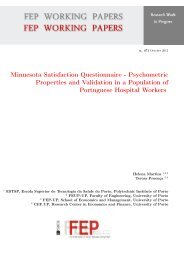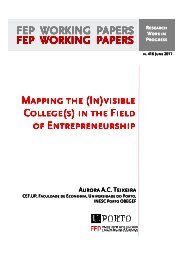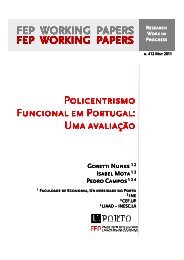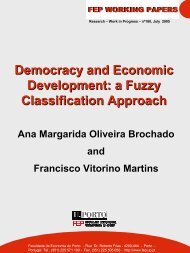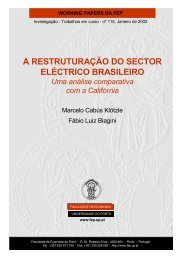FEP - Working Papers - Universidade do Porto
FEP - Working Papers - Universidade do Porto
FEP - Working Papers - Universidade do Porto
Create successful ePaper yourself
Turn your PDF publications into a flip-book with our unique Google optimized e-Paper software.
store earns more than the rival firms taken together. Aware of this, the shops at the mall<br />
could believe that a merger would benefit them, that is, increase their joint profit. In the<br />
next subsection, we study the effects of such a merger.<br />
Observe also that as the number of products increases to infinity, the price of the<br />
bundle increases to 2t at the department store and to 3t at the shopping mall. Moreover,<br />
the higher is n, the higher is the difference between the price of the bundle of goods in<br />
the two extremes. As a result, the department store captures an increasing share of the<br />
market (in the limit, it actually captures the whole market). Profits at the department<br />
store increase to 2t while the profits at the shopping mall initially increase (are maximal<br />
for n = 2) but then decrease to zero.<br />
When the number of products tends to infinity, the department store becomes monopo-<br />
listic in the market, since all consumers purchase the bundle there. However, the price she<br />
charges for the bundle remains bounded by 2t, because additional price increases would<br />
lead to a loss of consumers to the shopping mall. Then, although not buying from the<br />
shopping mall, consumers benefit from its existence.<br />
3.2 Competition between two department stores<br />
Now, we consider the case in which there are two department stores, one at each extreme<br />
of the city. Each department store chooses the price to charge for each of the n products,<br />
with the objective of maximizing its profit, taking as given the prices set by the other<br />
department store. 10<br />
Proposition 2. In the case of competition between two department stores:<br />
(1) The price of the bundle is equal to the transportation cost parameter:<br />
PL = PR = t, with<br />
n�<br />
|piL − piR| ≤ t.<br />
i=1<br />
10 This is an extension of the case analyzed by Lal and Matutes (1989), where both department stores<br />
sell only two products (n = 2).<br />
13



